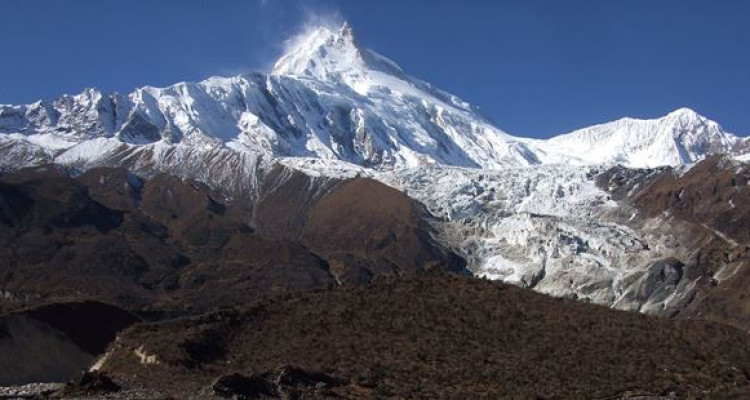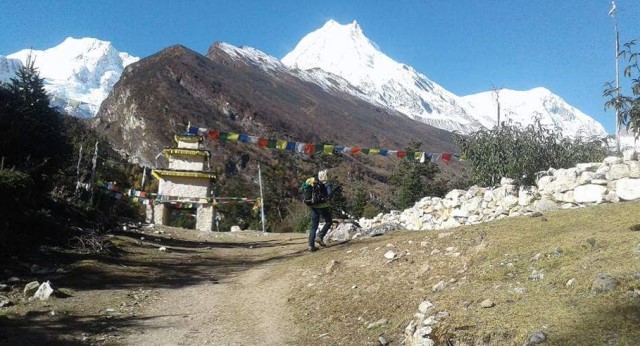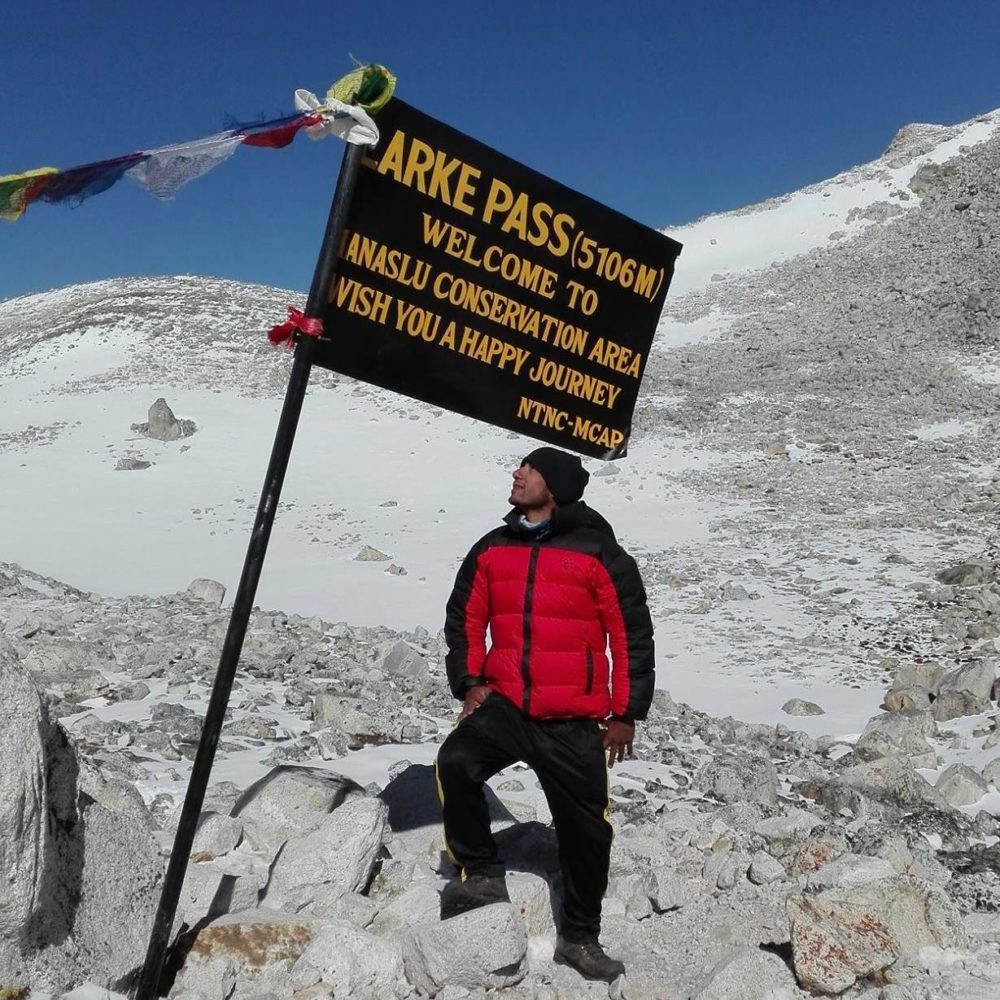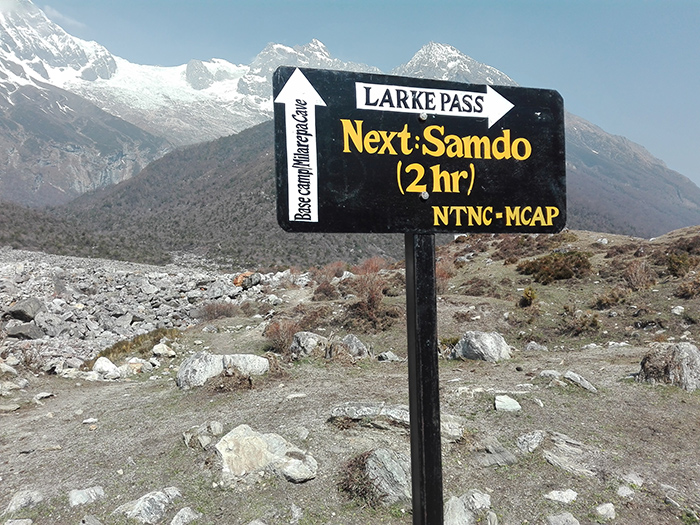May 3, 2023

The Manaslu region of Nepal is known for its unmatched beauty, with the majestic Manaslu mountain standing tall at 8,156 meters. The surrounding mountains, including Ganesh Himal, Himlung Himal, and Annapurna II, add to the stunning landscape. The trek takes you through lush forests, remote villages, and high mountain passes, offering breathtaking views of the snow-capped peaks. The region is home to a diverse range of flora and fauna, including rare and endangered species such as snow leopards and Himalayan tahr. The Manaslu Trek is a unique and unforgettable experience for any nature lover or adventurer.
The Manaslu Trek is a popular trekking route in Nepal that takes you around the majestic Manaslu mountain, which stands at 8,156 meters tall. The trek takes you through remote villages, lush forests, and high mountain passes, offering stunning views of the surrounding Himalayan peaks.
One of the reasons why the Manaslu Trek has become popular is because it offers a more remote and unspoiled trekking experience compared to other popular routes such as the Annapurna Circuit and Everest Base Camp Trek. The Manaslu region is relatively untouched and is home to a diverse range of flora and fauna, making it an ideal destination for nature lovers.
The trek starts in the small town of Arughat, located in the Gorkha district, about a 7-8 hour drive from Kathmandu. From there, you will follow the Budhi Gandaki River and cross numerous suspension bridges as you make your way towards the Manaslu mountain.
As you trek through the remote villages, you will have the opportunity to interact with the locals and learn about their customs and way of life. The people in this region are mainly of Tibetan origin and follow the Tibetan Buddhism religion. You will get to visit several Buddhist monasteries and see the colorful prayer flags that adorn the villages.
One of the highlights of the trek is crossing the Larkya La Pass, which stands at an elevation of 5,135 meters. The pass offers breathtaking views of the surrounding mountains and glaciers, and it is a challenging but rewarding experience.
After crossing the pass, the trek descends into the beautiful Bimthang valley, which is surrounded by snow-capped mountains. You will pass through several traditional villages such as Tilije and Tal, where you can see the locals going about their daily lives.
The trek ends in the town of Besisahar, where you can catch a bus back to Kathmandu. Overall, the Manaslu Trek is a challenging but rewarding trek that offers a unique cultural and scenic experience. The trek takes around 14-20 days to complete, depending on the itinerary you choose. If you’re looking for a more remote and unspoiled trekking experience in Nepal, then the Manaslu Trek is definitely worth considering.
Route
The Manaslu Trek route takes you around the Manaslu massif, the eighth highest mountain in the world, and through some of the most remote and pristine landscapes in Nepal. The trek starts from Soti Khola and goes through the Budhi Gandaki valley, passing through several remote villages such as Machhakhola, Jagat, Deng, Namrung, and Samagaon, among others. You will cross several high passes, including Larkya La Pass, which is the highest point on the trek at an altitude of 5,160 meters. The trek also takes you through lush forests, river valleys, and traditional Nepali villages, offering a glimpse into the local way of life.
Itinerary
The Manaslu Trek can take between 14-20 days, depending on the route you take and the pace you set. Here is a sample itinerary:
Day 1: Drive from Kathmandu to Soti Khola (710m),
Day 2: Trek from Soti Khola to Machhakhola (900m),
Day 3: Trek from Machhakhola to Jagat (1410m),
Day 4: Trek from Jagat to Deng (1800m),
Day 5: Trek from Deng to Namrung (2630m),
Day 6: Trek from Namrung to Samagaon (3530m),
Day 7: Rest day in Samagaon,
Day 8: Trek from Samagaon to Samdo (3860m),
Day 9: Trek from Samdo to Dharmasala (4460m),
Day 10: Trek from Dharmasala to Bimthang (3700m) via Larkya La Pass (5160m),
Day 11: Trek from Bimthang to Tilije (2300m),
Day 12: Trek from Tilije to Tal (1700m),
Day 13: Trek from Tal to Jagat (1300m),
Day 14: Trek from Jagat to Besisahar (760m), then drive back to Kathmandu.
Highlights
The Manaslu Trek offers stunning views of the Manaslu massif, as well as other peaks such as Himlung Himal, Annapurna II, and Ganesh Himal. The trek also takes you through remote villages, where you can experience the traditional Nepali way of life and learn about their customs and culture. Some of the highlights of the trek include:
Preparing for the Manaslu Trek in Nepal can be a challenging yet rewarding experience. With a proper preparation plan in place, you can ensure that you are ready to tackle the challenging terrain and enjoy the stunning beauty of the Manaslu region. Here is a complete guide on how to prepare for the Manaslu Trek:
Physical Fitness: The Manaslu Trek involves long and strenuous days of hiking, sometimes at high altitudes. Therefore, it is essential to be physically fit and prepared for the trek. Cardiovascular exercise, strength training, and hiking practice are essential in the months leading up to the trek.
Mental Preparation: Trekking in a remote and unfamiliar region can be mentally challenging. Mental preparation can help to manage stress and anxiety that may arise during the trek. Familiarize yourself with the region, the trek route, and what to expect during the trek.
Get the Necessary Gear and Equipment: Make sure to invest in quality gear and equipment that will keep you comfortable and safe during the trek. Essential items include hiking boots, trekking poles, a sleeping bag, a warm jacket, waterproof clothing, and a daypack.
Acclimatization: The Manaslu Trek involves high altitudes, and it is important to acclimatize to avoid altitude sickness. Plan to spend a few days in Kathmandu before starting the trek to help your body adjust to the altitude.
Get Necessary Permits: Before starting the Manaslu Trek, you will need to obtain the necessary permits. This includes the Manaslu Restricted Area Permit, the Manaslu Conservation Area Permit, and a TIMS card. You can obtain these permits in Kathmandu.
Plan Your Itinerary: Decide on the duration of your trek and create a detailed itinerary. Consider rest days, side trips, and acclimatization days. Ensure that you have enough time to complete the trek safely and comfortably.
Stay Hydrated and Nourished: Trekking in the Manaslu region can be physically demanding, and it is important to stay hydrated and nourished. Carry enough water and snacks, and make sure to eat enough carbohydrates and protein to maintain energy levels.

The best time to go to Manaslu depends on your preferences and trekking experience. Generally, the best time to trek in the Manaslu region is during the spring (March to May) and the autumn (September to November) seasons.
During the spring season, the weather is relatively mild, and the blooming rhododendron forests make the trek a scenic delight. The temperatures are mild, and the skies are usually clear, providing spectacular views of the surrounding Himalayan peaks.
Similarly, the autumn season is also a great time to go trekking in the Manaslu region. The weather is dry and stable, and the skies are clear, offering panoramic views of the surrounding mountains. The temperatures are cooler than in the spring, making it a comfortable time for trekking.
During the monsoon season (June to August), the region receives heavy rainfall, making the trek challenging and hazardous. The trails become slippery and prone to landslides, and the views are often obscured by clouds and mist.
Similarly, during the winter season (December to February), the temperatures are very low, and the trails become snow-covered and difficult to navigate, making it challenging for even experienced trekkers.
The Manaslu Circuit trek covers a total distance of about 180 kilometers or 111 miles, beginning from Soti Khola. The average daily travel distance is about 12 to 15 kilometers or 7 to 9 miles per day . Depending on the itinerary, the trek usually takes between 13 to 18 days to complete. The trail offers stunning views of the Manaslu mountain range, diverse flora and fauna, and cultural experiences with local communities. The trek includes crossing the challenging Larkya La Pass, which is the highest point of the trek at 5,106 meters or 16,752 feet. Overall, the Manaslu Circuit trek is a rewarding and challenging adventure for trekking enthusiasts seeking a less crowded and remote experience in the Himalayas.
Preparing for a trek in the Manaslu region can be an exciting and daunting experience, especially when it comes to packing. Here is a packing list for the ultimate Manaslu trek:
Clothing:
Equipment:
Optional:
It is important to pack as lightly as possible while still having all the essential items. Remember to layer your clothing and pack for a range of temperatures and weather conditions. Bring comfortable and well-fitted hiking boots and break them in before the trek to avoid blisters and discomfort. Lastly, ensure that all equipment and gear are in good condition and functioning properly before departing for the trek.
The Manaslu Conservation Area is home to a rich variety of flora and fauna. Located in the Himalayas of Nepal, this region offers a diverse range of habitats, from alpine forests to sub-tropical jungles. Here is a closer look at the flora and fauna of the Manaslu Conservation Area:
Flora:
The Manaslu Conservation Area boasts a wide variety of plant species, including rhododendrons, magnolias, oaks, maples, and birches. The region also has a rich collection of medicinal plants, including Himalayan yew, Himalayan rhubarb, and juniper.
Fauna:
The Manaslu Conservation Area is home to a diverse range of wildlife species, including snow leopards, Himalayan tahr, musk deer, and Himalayan black bears. The region also has several rare bird species, such as the Himalayan monal, the Koklass pheasant, and the white-throated dipper.
Conservation Efforts:
The Manaslu Conservation Area is managed by the government of Nepal and several non-governmental organizations to protect and conserve its unique biodiversity. Conservation efforts include the creation of buffer zones around the conservation area, community-based conservation projects, and sustainable tourism initiatives.
Trekking in the Manaslu region provides an opportunity to witness the stunning beauty of the Himalayas while experiencing the rich diversity of the region’s flora and fauna. It is important to respect the environment and follow responsible trekking practices to help protect the Manaslu Conservation Area for future generations.
The Manaslu region of Nepal is not only known for its stunning natural beauty, but it is also home to a rich culture and tradition of the people living in the region. The region is home to several ethnic communities, including the Gurungs, Tibetans, and Tamangs, each with their unique customs and traditions. Here is a closer look at the culture and traditions of the people living in the Manaslu region:
Festivals and Celebrations:
The Manaslu region is home to several colorful festivals and celebrations throughout the year, such as the Tihar, Buddha Jayanti, and Lhosar festivals. During these celebrations, people dress in traditional attire, perform cultural dances and music, and offer prayers to their deities.
Traditional Music and Dance:
The people living in the Manaslu region have a rich tradition of music and dance, with each ethnic community having their unique styles. Traditional musical instruments such as Madal, Damphu, and Sarangi are commonly used, and dances such as Ghatu, Maruni, and Tamang Selo are performed during festivals and cultural events.
Cuisine:
The Manaslu region has a unique cuisine that reflects the traditions and culture of the people living in the region. Traditional dishes such as Dal Bhat, Thukpa, and Momos are commonly eaten, and locally grown produce such as potatoes, barley, and buckwheat are used in cooking.
Traditional Clothing:
The people living in the Manaslu region have their unique traditional clothing, which reflects their cultural identity. The Gurungs, for example, wear a traditional dress called Ghegu, while the Tamangs wear a traditional dress called Tamang Selo.
Religion:
The people living in the Manaslu region follow various religions, including Buddhism, Hinduism, and Shamanism. Buddhism is particularly prevalent in the region, and several monasteries and chortens can be found along the trekking routes.
Trekking in the Manaslu region provides an opportunity to experience the unique culture and traditions of the people living in the region. It is essential to respect their customs and traditions and to gain a deeper understanding of their way of life to enrich the trekking experience.

The Larkya La Pass is one of the most challenging and rewarding aspects of the Manaslu Trek. At an altitude of 5,160 meters (16,930 ft), crossing the pass requires trekkers to be physically and mentally prepared. Here are some of the challenges and rewards of crossing the Larkya La Pass:
Challenges:
Rewards:
In conclusion, crossing the Larkya La Pass is a challenging and rewarding experience that requires proper preparation and planning. The sense of accomplishment, panoramic views, cultural experience, and unspoiled nature make it a must-do for adventure seekers trekking in the Manaslu region.
Trekking in the Manaslu region can be a challenging and rewarding experience, but it is recommended that trekkers hire a guide and/or porter to assist them on their journey. Here are some of the advantages of trekking with a guide and/or porter in the Manaslu region:
In conclusion, trekking with a guide and/or porter in the Manaslu region has many advantages, including local knowledge, safety, navigation assistance, porter assistance, cultural experience, and supporting the local economy. It is recommended that trekkers consider hiring a guide and/or porter to enhance their trekking experience in the Manaslu region.
Nepal is home to some of the world’s most popular trekking routes, and the Manaslu Trek is no exception. Here’s a comparison of the Manaslu Trek with other popular trekking routes in Nepal:
Everest Base Camp Trek: The Everest Base Camp Trek is undoubtedly the most famous trekking route in Nepal. The route is more crowded and developed than the Manaslu Trek, with many teahouses and lodges along the way. The trek to Everest Base Camp is also longer and more physically demanding than the Manaslu Trek, with altitudes of up to 5,545 meters. However, the views of the world’s highest mountain make it a once-in-a-lifetime experience.
Annapurna Circuit Trek: The Annapurna Circuit Trek is another popular trekking route in Nepal. The trek is longer than the Manaslu Trek and takes trekkers through a variety of landscapes and cultures, including lush forests, high-altitude deserts, and traditional villages. The trek also crosses the Thorong La Pass, which is higher than the Larkya La Pass on the Manaslu Trek. The Annapurna Circuit Trek is more accessible than the Manaslu Trek, with better transportation links to and from the trailhead.
Langtang Valley Trek: The Langtang Valley Trek is a shorter trek than the Manaslu Trek and is a good option for those with limited time. The trek takes trekkers through beautiful forests and past traditional villages, with stunning views of the Langtang range. The trek is less crowded than the Manaslu Trek and offers a more relaxed pace.
Upper Mustang Trek: The Upper Mustang Trek is a remote and unique trekking route in Nepal. The trek takes trekkers through a high-altitude desert landscape, with stunning views of the Himalayas. The trek is less physically demanding than the Manaslu Trek but requires a special permit due to the restricted nature of the region. The Upper Mustang Trek offers a glimpse into a unique culture and way of life.
In conclusion, the Manaslu Trek is a challenging and rewarding trekking route in Nepal, with stunning views of the Himalayas and a unique cultural experience. While there are other popular trekking routes in Nepal, each has its own unique features and challenges. The choice of which trek to embark on depends on personal preferences, time availability, and fitness level.
Trekking in the Manaslu region is a unique and enriching experience. However, it is important to do it responsibly to minimize the negative impact on the environment and local communities. Here are some dos and don’ts for responsible trekking in the Manaslu region:
Dos:
Don’ts:
By following these dos and don’ts, you can help to ensure a positive and sustainable experience for both yourself and the local communities in the Manaslu region.
Acclimatization is a crucial aspect of high-altitude trekking, as it allows the body to adjust to the decrease in oxygen levels. Here are some tips for acclimatizing properly during the Manaslu Trek:

Way up to Larke pass in Manaslu trek
The Manaslu Tsum Valley Trek is a popular trekking route in Nepal that combines two beautiful regions, the Manaslu Circuit and Tsum Valley. This trek takes you through the remote villages of Tsum Valley and offers stunning views of the surrounding mountains.
The Manaslu Tsum Valley Trek starts in the town of Arughat and follows the Manaslu Circuit route until the town of Philim. From there, the trek deviates from the Manaslu Circuit and heads towards the Tsum Valley. The route then loops back to the Manaslu Circuit and eventually returns to Arughat.
The Tsum Valley is a hidden gem in Nepal, located in the northern part of the Gorkha district. This valley is known for its ancient Buddhist monasteries, chortens, and mani walls. The trek provides a unique opportunity to experience the culture and traditions of the local people.
The Manaslu Tsum Valley Trek is a moderately difficult trek that takes approximately 20-22 days to complete. The trek covers a distance of around 260 kilometers and reaches an elevation of 5,160 meters at the Mu Gompa.
Joining a trek is a great option for solo travelers who want to experience the Manaslu Tsum Valley Trek with other like-minded people. Joining a trek also provides a cost-effective option for those who want to trek without hiring a private guide or porter.
Manaslu Trek in Nepal is a 13-day trek through the remote Manaslu Conservation Area, covering 180 kilometers and reaching 5,135 meters at Larkya La Pass. The trek offers stunning views of diverse landscapes, flora and fauna, and cultural experiences with the local people. It is a challenging but rewarding trek suitable for moderately fit people, offering breathtaking views of the Himalayas.